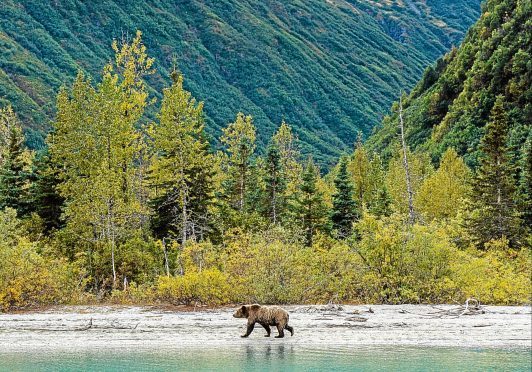Happy New Year, and welcome to 2018! It occurred to me as I eyed its blank canvas stretching off into imponderable distance, a landscape fertile with hope, packed with life’s possibilities, that 20 years ago this year I went to Alaska, and my life’s compass realigned itself.
It was a commission from the BBC Natural History Unit to make two programmes for Radio 4 about the relationship between people and wildness.
It was a good time of my life to go there. I already understood the place of the lone wolf in nature’s scheme of things. My days of climbing mountains to get to the top were behind me, and instead I had begun to wander a path that led back to older simplicities. In the process, I had become something of a lone wolf myself.
What was missing was a deeper relationship with wildness, a way to tap into nature’s secrets, and my motivation was that I wanted to write them down. The way that I found was watching golden eagles.
Whenever I talk about nature writing now, or even nature watching, I suggest going alone, even if it’s only once, even if it’s only half a mile along the floor of a glen, just far enough to feel untethered, to slip the noose of the pack. Then sit somewhere along the way and be still. Learn to keep the company of nature, learn to listen to the land.
When I go alone in wild places, I sometimes feel the absence of wolves. Or rather I feel the distant, elusive nature of their old presence, for no land that has sustained wolves ever loses completely the imprint of their reign.
As things stand, the golden eagle is our top predator, and great as it is, it is simply not predator enough. No bird is. Nor does it challenge us. We are never less than comfortable with it, for its presence gives us no pause for thought.
Then I went to Alaska and met a grizzly bear on Kodiak Island at 20 paces and that gave me pause for thought. I thought: my species is not in charge of this situation.
It was the first time I had been in such a situation but instead of being fearful, I was thrilled by it. That awareness was the single most powerful thing I ever learned, and I brought it home with me. I wanted it to be a part of my native land because it belongs here too, and I had been robbed of it. I wanted to reclaim my despoiled inheritance.
Also in Alaska, I saw fresh wolf tracks in the mud, and that, too, gave me pause for thought. I thought: he was here, an hour ago, what if our paths had crossed, I might have seen him coolly consider my heart-in-mouth presence, we might have locked eyes for a moment. What might I have read there?
My guide on Kodiak was a man called Scott Shelton. His way of interacting with the bears was to talk to them. He told me: “I try to tell people it’s not foolish to talk to animals. I want the animals to feel the humans are somewhat calm. For some people it can be very stressful around their first sighting of a Kodiak bear, but when I bring them here I want them to respect the animal and to learn from the animal. It takes time. But when people leave here they have learned a lot more than they could from reading or movies … it’s reality out here, the way the animals interact, carry on their daily lives. We can just observe. It’s a very good learning tool to spend time with any type of animal you’re interested in.”
I mentioned my interest in wolf reintroduction in Scotland and asked him what he thought: “I think it’s a wonderful thing to do, for people to realise that there are wild creatures out there and the land belongs to them, and no matter how big or small they are, it’s very important for man to learn to co-exist in the same environment.
“I think the wolf can manage deer better than man can and, on the educational side, it would be good to sit back and watch how the wolf manages the deer. And these animals deserve a second chance.”
From watching Scott at work, I came home with a clear idea of just how much of the ancient bond between man and wildest nature is still recoverable. At the end of that year, 20 years ago, I learned that Scott had died from a stroke. I felt sorrow for the bears and the wolves, for their loss.
The point is, embrace the new year. You never know what’s about to cross your path.
